#minoan dress
Text
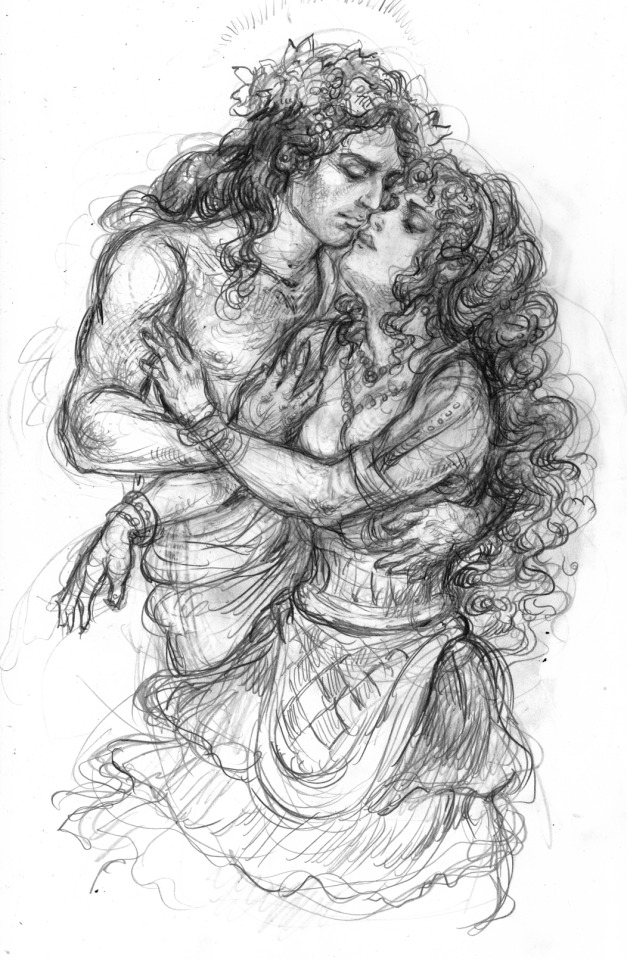
Dionysus and Ariadne for @margaretkart! She's wearing the famous Minoan priestess outfit with belt, apron and flounces, with a pose inspired by classic romance comic artist Nell Brinkley.
#illustration#art#sketchbook#dionysus#ariadne#dionysus x ariadne#greek mythology#greek myths#greek gods#ancient greek mythology#sketch#drawing#romance art#minoan costume#minoan dress#minoan#minoan woman#ancient greece
1K notes
·
View notes
Photo
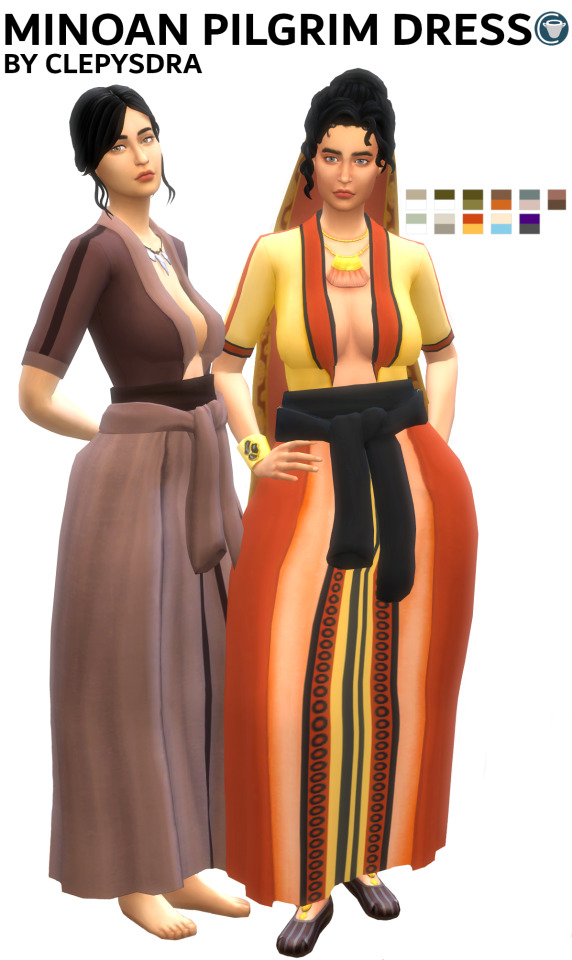
Minoan Pilgrim Dress
Based off a clay statuette of a Minoan woman in a state of worship from Piskokefalo.
Long dress category
11 swatches
Base game compatible
Feminine
DRESS DOWNLOAD - Dropbox (no ads)
#my cc#my cas cc#s4cc#ts4cc#sims 4#sims 4 cc#ts4mm#ts4 dress#minoan#crete#cretan#greek#greece#bronze age#ts4 history#ts4 history cc#ts4 historic#ts4 historic cc
229 notes
·
View notes
Text
Learned today that it is not, in fact, possible to cover the history of the Hittite Empire, Minoan Crete, Mycenaean Greece, the Bronze Age Collapse, and Archaic and Classical Greece in 50 minutes. I did my best.
I think I spent too long explaining Minoan and Mycenaean pottery and had to rush to skim over little things like the development of Athenian democracy. What can I say, I have a type.
#Also I was dressed in my Minoan Snake Goddess outfit#brought my big plush IKEA snake and everything#Artemis rambles
24 notes
·
View notes
Text

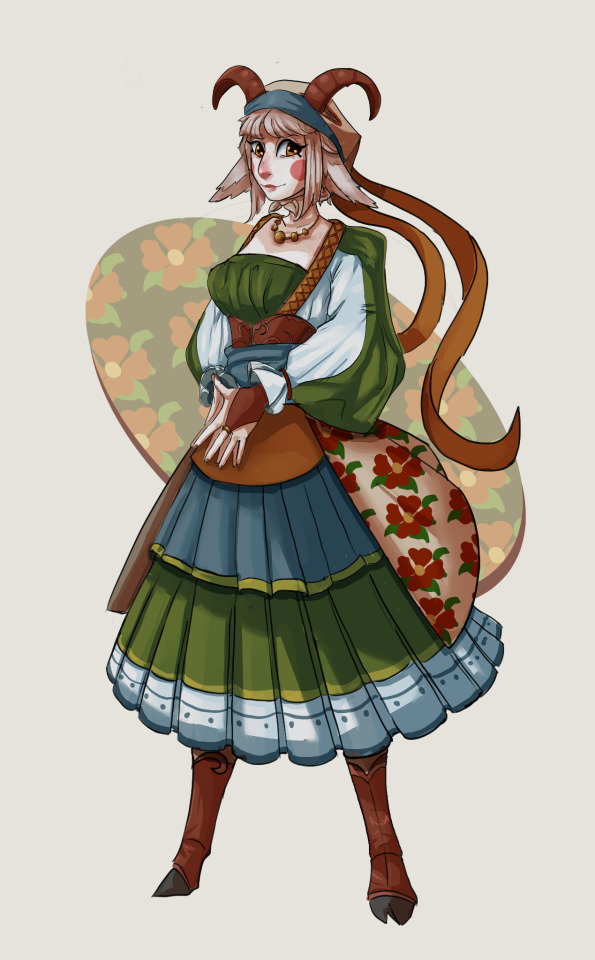
Drew a folk-goat.
Outfit is inspired by a combination of eastern-European dresses combined with ancient minoan fashion.
#my art#art#artwork#bondead#monster girl#illustration#oc#character design#oc art#folk aesthetic#folk dress#folklore#minoan#east europe#pinup art#pinup#cottagecore#ancient greece
41 notes
·
View notes
Text

Minoan bull-leaping mermaid, anyone?
The prompt said Ancient Greece and you know I gotta give my Bronze Age girlies their representation!
Featuring Minoan octopus, flag pattern, murex dyed fabric and crocus dress patterns. Her tail is a lobster tail as the layered Minoan skirt looks a lot like one and her bull is a sea cow!
Thanks again to @chloe.z.arts on instagram for creating this prompt list!
#mermay#minoan#mermaid#manatee#digital drawing#illustration#Greek#historical dress#ancient greek#art tag#oc
18 notes
·
View notes
Text

The Lovers of Akrotiri 👩❤️💋👩🐦⬛🌺🌞
Junes illustration is a sweet scene of two Minoan girlfriends, that plays on the saffron gatherer motif but this time with a stylised lily landscape reminiscent of the “Spring Fresco of Akrotiri”. 🐦⬛🌺🌞
Their dresses are based on frescos of women and goddesses from the Minoan city of Akrotiri that was preserved in a volcanic eruption in the 16th century BCE🌋

#tagamemnon#flaroh illustration#minoan#ancient greece#illustration#happy pride 🌈#pride month#lesbian history#queer history
2K notes
·
View notes
Note
Your art of Elwing and the birds makes me so happy! I too am thrilled by Valinor biodiversity! And your clothing for her is so beautiful!
-@outofangband
thank you!! There has to be sooo much going on in Valinor in terms of flora and fauna (just as a treat for me there should also be mammoths in the north)..... And I always love thinking about Elwing Just Chilling for really the first time ever after the first age ends. Let my girl have hobbies
1 note
·
View note
Text

Odysseus and his girls idk
Design notes beneath the cut
Circe is inspired by minoan frescoes in her wardrobe, but her overall look is kind of "witchy surfer girl that smells of patchouli" as the main inspo lol since shes the daughter of Helios.
Penelope is supposed to be an ideal woman so she is largely inspired by minoan snake goddess/mycenean frescoes. very typical bronze age depiction of a woman. shes very ornate bc she doesnt move a lot. Lots of blue that is specific to Odysseus.
Calypso is supposed to be from the tyrian/carthaginian region (northwest africa) with berber inspiration for her face tattoos. lots of purple in her designs due to carthaginian inspo. All this is bc her father Atlas is believed to have etymology from North Africa/the Berber language (his name may come from "Adras" which is the word for mountain.)
Nausicaa is the least ornate bc shes unmarried, so she hasnt recieved a lot of gifts that would come from marriage like jewelry. she is dressed like the classical period, and has no makeup to show that she's younger than the other women. idk why shes a redhead i just like the idea. She'd be probably from modernday Corfu, which has associations to Artemis (which she also has!), and has the oldest Doric style temple, which added to her classical appearance.
Odysseus’ “prize” (read: sex slave) is from the neighboring cities around Troy, so she’s already not as ornate as the rest of his women as seen in her dress. girl was probably a goat herder before being taken as a prize. the metal she wears is bronze. her hair was shaven to indicate she’s a slave and i intend to redesign her to keep that shaven hair quality. Minoan frescoes are design inspo there.
Odysseus is just purely vibes based. His hair is wavy bc waves, with two noticeable scars from youth. Something about "despite everything, it's still you". The gems in his necklace are the same color as the bodice of Penelope's dress.
#odysseus#odyssey#penelope#circe#kirke#calypso#kalypso#nausikaa#nausicaa#the odyssey#homer#epic the musical#mature tag bc boobie woobies#my art#i snuck in the war prize from the iliad. i have many thoughts about her rn#iliad#the iliad#idk what else to tell u. muah
179 notes
·
View notes
Text
Minoan Heanos
The distinctive open-front dresses worn by Minoan women are probably even more iconic than the multi-layered kilts. Over time, there's dispute whether the garment is one piece or a separate bodice and skirt, but currently the one-piece theory is in ascendance.

The word heanos is derived from the Linear B logogram *146, wehanos. The wes- prefix, which is the squiggle in the middle, indicates a garment. Bernice Jones believes that this logogram represents the garment worn by Minoan men and women.
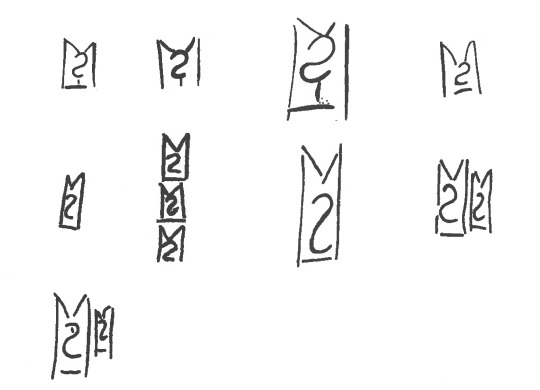
Marie-Louise B. Nosch, The Textile Logograms in the Linear B Tablets, pp 133-138
More research and construction below the cut:
The theory that the garment is a full-length tunic is further supported from imagery from the time, like these figures from the c. 1400 BCE Hagia Triada Sarcophagus. This detail from the sarcophagus shows three figures in some kind of procession, 2 women and 1 man. The woman at left wears a tunic with some kind of pelt as a skirt, and the other 2 figures wear tunics without anything over them, showing that they are one continuous, ankle-length garment.
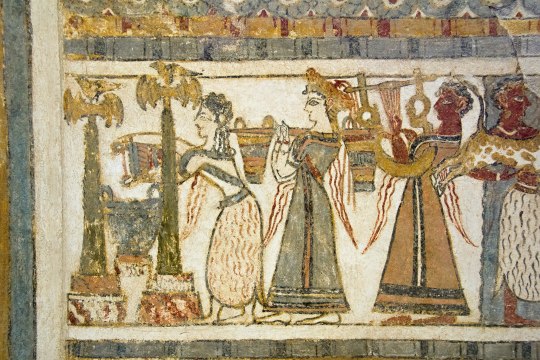
Some of the most important resources for interpreting how the heanos was constructed comes from the two women depicted in the House of the Ladies in Akrotiri, wherein the side seams of the tunic are clearly visible running along the side of the body and under the arm.
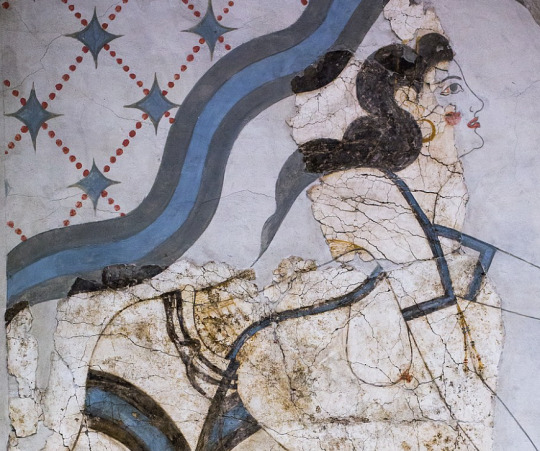
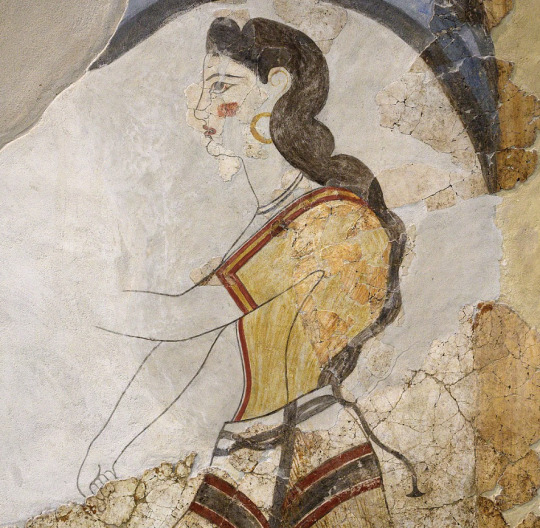
details of figures from the House of the Ladies, Akrotiri, via Wikimedia Commons
advadbsvasb
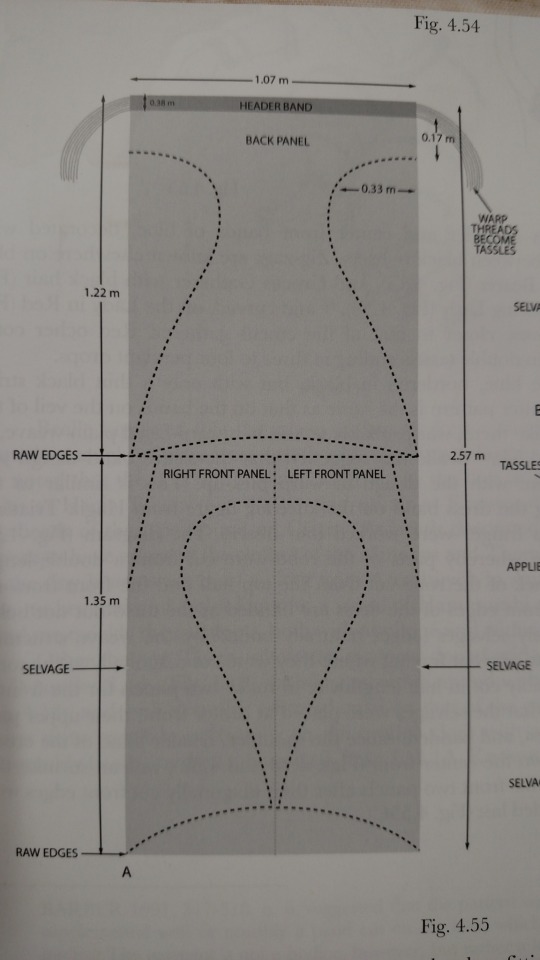

Diagrams from Bernice Jones' book Ariadne's Threads, p. 82, via Gorgeous Tangents
The heanos itself is made of 3 pieces of fabric: 1 back and 2 fronts. These diagrams show a concave hem like on the labrys-shaped kilt but I went with a straight hem, which is an equally valid option. The end of the sleeves are level with the edge of the hem at the widest point. This would probably be the width selvage-to-selvage on the fabric, being narrower than fabric widths commonly are today. There are 4 seams: the shoulder seam, the two side seams, and a front seam (optional, but recommended if you would prefer not being arrested.) It may be tempting to fold the fabric across the shoulder, so the only sewing is side seams and a neck hole, but this makes a weaker garment overall. I used this as a shortcut in my fitting muslin and it caused tears and weak points at the three points of the front opening.

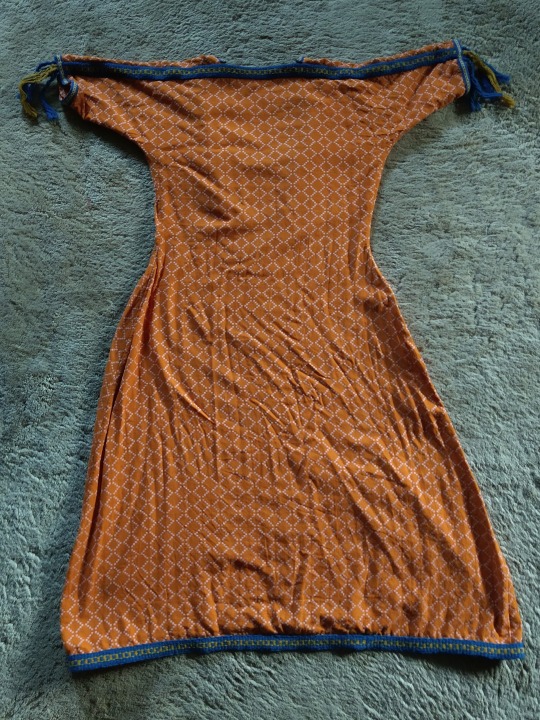
my fabric was a lightweight, moderately loose-woven cotton with a supplementary weave pattern in squares and diamonds. Linen or wool would have been more accurate but also? much harder to find from online quilting stores selling fabric for affordable prices. The main fabric is dark orange and the pattern is made out of pink/lilac threads. This weaving technique resulted in a LOT of long floats (unsecured expenses of thread) on the back--you can see how the wrong side of the fabric is much pinker than the right side. These floats could snag easily if I wasn't careful, so while it made a very effective visual for this tunic, I do not think that this fabric type would be viable for everyday wear. I'll leave it to people who actually know about weaving to ponder what more accurate weaving techniques would be.
Construction
The overall pattern is basically a T-shaped tunic, and the most important measurements are shoulder circumference, shoulder width, bust circumference, and the shoulder-waist length. In addition, you need measurements for the bicep, waist, shoulder-navel length, and hip circumference. After working out the fit with a muslin, I ended up with this pattern, 1 of 4 identical quarters.

Your first impulse may be to make the tunic very close-fitting, since the depictions in frescoes are skin-tight, but since the pattern has no added gusset this is a recipe for Cannot Move Arm. So I gave a very generous curve under the arm, which also made the dress look better when my arms were down, avoiding armpit wrinkles. I continued that ease into about an extra 2 inches added on to my waist measurement and plenty of extra space around my hips so that I could do exciting things like Sit Down.


I sewed the shoulder and side seams using the machine, and felled the raw edges on each side of the seam by hand with a whipstitch. I foided back the front edges of the v-neck instead of cutting them, which was a tip I got from the Gorgeous Tangents blog. This strengthens the neckline and keeps it from stretching, and also means that everything can be readjusted if you have size fluctuations or just want to modify the tunic into something more or less modest.
I whipstitched the front edges together by hand--the contrasting selvage didn't matter because it would be covered up by trim. I ended up cutting the tunic a liiiittle shorter than I wanted, so I finished it with some leftover bias binding instead of hemming it to conserve as much length as possible.
Trim

I custom-ordered the woven tape trim from Long Creek Mercantile. Both are made of wool--the "header band" and the hem trim are 1 1/4" wide and the center-front and cuff trim are 3/8" wide. I observed that most images of the Minoan heanos show trim with two colors at most, in a simple geometric or linear pattern, so I consciously restrained myself from ordering anything more elaborate. The clothing on Minoan frescoes is characterized by strongly contrasting colors, so blue trim was the most obvious, and best-looking option. Orange tunics with blue trim appear multiple time in art like the "Dancing Lady" fresco from Knossos:

Dr. Jones suggests that the band across the shoulder would historically have been a header band--a band of threads woven at the beginning of a project in order to properly space the warp bands (see her diagram at the beginning). That may be a reason why the shoulder trim often depicted under the front or sleeve trim, as shown above. Regardless, the trim almost always coordinates.
I sewed on the shoulder trim by hand, the sleeve and hem trim by machine, and the center-front trim with a combination of both.
Tassels
Many frescoes from Akrotiri and Hagia Triada show the ends of the supposed header band turned into tassels. This embellishment is not universal among heanoi, as you can see from the "Dancing Lady" above, but it does add a fun little something!

(yes, my Lounging Pants are very fashionable)
I turned the excess ends of the shoulder "header band" trim into fringes, knotting the yellow ones into a lattice and turning the blue yarns into tassels. The lattice-tassel appears on a fresco from Hagia Triada:

Reproduction of fragmentary fresco from Room 14 at Hagia Triada, Crete
The saffron gatherers from Akrotiri shown below have clearly displayed fringes at the ends of their sleeves. The one on the left has red fringes that appear knotted or ravelled/unravelled in an undulating pattern, and the one on the right has fringes that may be either beaded with papyrus-shaped leaves or cut into short tassels.
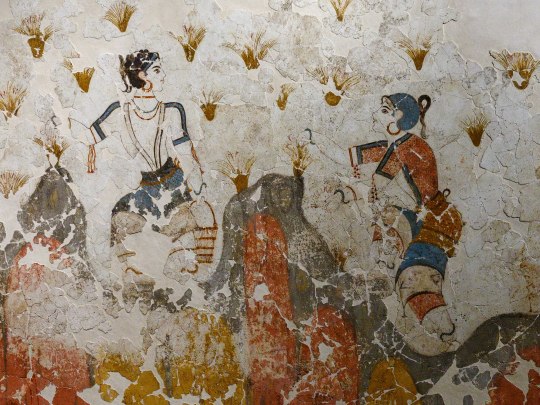
Another option is leaving the fringes loose, as seen in the Akrotiri frescoes from Xeste, room 3:
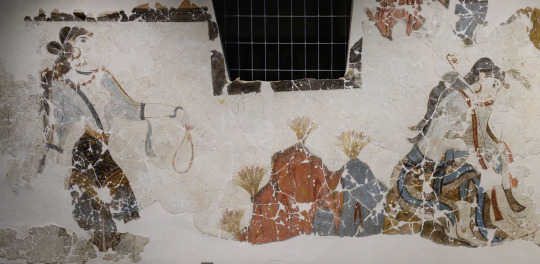
The final garment was super comfy, actually! It's much simpler to create than I thought it would be based on the frescoes, which made it all feel pretty magical when everything came together. I did think it was a little unusual how tailored this garment is, and the potential waste of fabric that comes from a shaped garment, especially compared to how later ancient greek clothing was mainly rectangles. I don't know enough about bronze-age and earlier clothing to have any idea how typical this was, since I'm extremely Not an expert on this subject, but am always open to learning more!
498 notes
·
View notes
Text
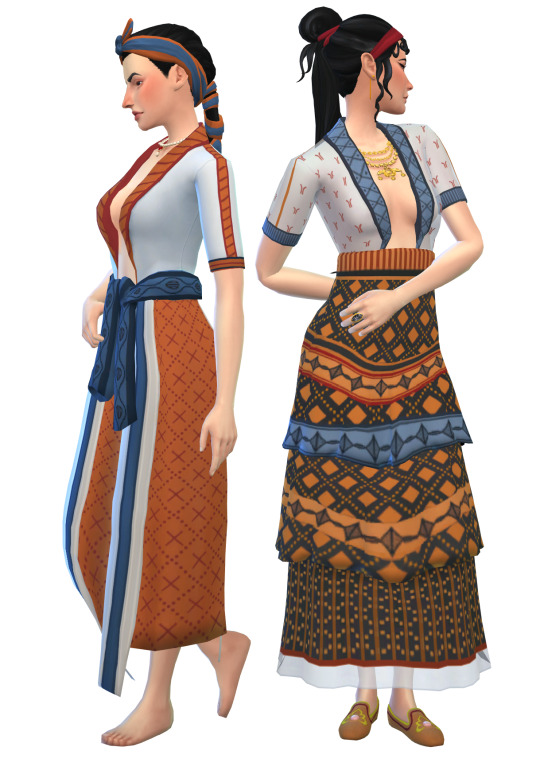
Crocus flowers - poisonous, but beautiful!
52 notes
·
View notes
Text
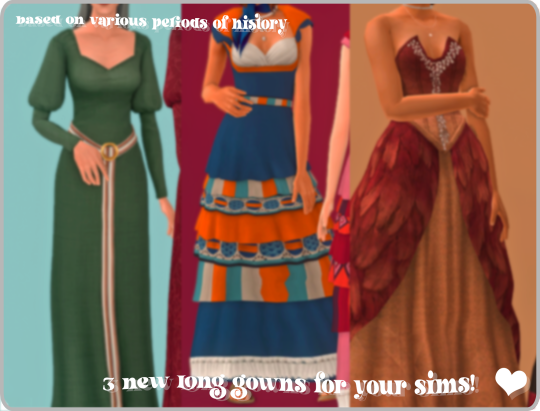

i've been on a historical challenges binge recently, so have the fruits of that! starting off with: 3 new, long gowns for your stuck-in-the-past sims! they are each meant for different periods of history 🥰
i do plan to add on to this collection, as i've seen a lot of very cute hairs, accessories, etc. that ts2 doesn't have yet 👀 so keep an eye out! more info on all 3 dresses under the cut 👇
DOWNLOAD: SFS | MF ⌛
credits go to @my-historical-sims, @teanmoon, @clepysdra, and @zx-ta for the original ts4 creations! and to ea/maxis for the original mesh of the swan dress, which is technically a sims medieval to sims 4 to sims 2 conversion 🥰
ITEMS INCLUDED
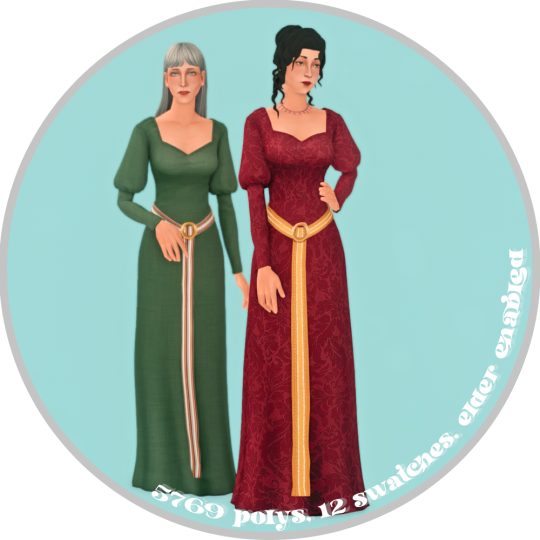





4T2 MY-HISTORICALSIMS' MEDIEVAL BELTED DRESS (SFS | MF)
- made as a late birthday present for @spell-bloom 😍
- mesh is yf-af only, but elder-enabled
- everyday, formal, outerwear
- 12 swatches
- 5769 polys!
4T2 TEANMOON'S MINOAN MAIDEN DRESS (SFS | MF)
- a redux of a dress i posted to the simscord literally a year ago and should never have posted tbh, the original was so bad
- paired with 4t2 @clepysdra's gladiator sandals by me
- meshes for tf-af, but again, elder enabled
- everyday & formal
- 6 swatches
- 7190 polys!
4T2 ZXTA'S SIMS MEDIEVAL SWAN DRESS (SFS | MF)
- expect some gaps between the cross-fabric at the back and the actual back, since they're painted on
- mesh is yf-af only, but elder enabled
- everyday & formal
- 6 swatches
- 3028 polys
SWATCHES



MEDIEVAL BELTED, MINOAN MAIDEN, AND LASTLY SWAN

if there are any issues that you find with this set, please don't be afraid to let me know! part 2 will come whenever i have the energy honestly, so don't get too excited. happy simming though, and when you download this, do keep in mind,

290 notes
·
View notes
Text

"Mycenaean women put their own spindles to splendid use, producing luscious cloaks and long, richly patterned or striped skirts. Far from resigning themselves to the weaving rooms, they travelled in chariots, performed songs or poetry to the accompaniment of lyres, and carried wheatsheaves for public ceremonies and rituals, as vibrantly coloured frescoes from the palace at Mycenae reveal. In one of the most enigmatic paintings, one woman holds a sword, another a spear, while two tiny men, one painted red and the other black, float mysteriously between them, like toy models or thought bubbles. Through their contact with the divine, perhaps, the women pictured gain agency over the men’s fate. Hera, Zeus, Poseidon and a female birth and death goddess known as Potnia were among the deities the Mycenaeans are known to have worshipped. While Mycenaean women clearly played an important role in religion, their political position within the palaces was weaker than that of their Minoan counterparts, and secondary to the men’s. Each Mycenaean palace complex was presided over by a male ‘wa-na-ka’ or wanax.
Surviving clay writing tablets provide just as fascinating an insight into the lives of women in the real palaces of the Mycenaean era. The fullest collection of tablets comes from a pair of rooms in the palace complex of Pylos, but Knossos, the former Minoan capital, was also a key repository. A total of 4,476 tablets have been preserved across the two sites. Among these there are references to more than 2,000 different women. Unlike Linear A, the Minoans’ writing system, the Mycenaeans’ similarly syllabic Linear B has been successfully deciphered. Working (as opposed to non-working elite) women were denoted by signs resembling an abstract impression of the female form. ‘Woman’ was conveyed by two dots for breasts, legs joined to suggest a long skirt of the kind Mycenaean women wore, and a curved line where her head would be, suggestive of long or dressed hair (in the sign for a man, by contrast, there is a straight line for the head).
The women referred to in the tablets were employed in a wide range of jobs, many of them familiar from the Homeric epics. In the Odyssey, women grind wheat and barley, ‘the marrow of men’, at mills. There were ‘flour-grinders’ at the palace in Pylos. In both epics, women weave, whether royal or servile. Andromache works in the Trojan palace with a loom and distaff while ordering her servant women about their work. Helen embroiders a purple cloth with scenes from the Trojan War as if she were telling the story of the poem herself. And as we have seen, Penelope weaves and unweaves a funeral shroud for her father-in-law, Laertes. The women who wove at Pylos and Knossos were no less versatile in their handiwork. They managed something like a textile industry, producing goods for export as well as the palace community, and worked in groups according to specialism. There were wool-spinners and carders, linen- and leather-workers, finishers and headband-makers for horses. These women usually worked separately from men, but at Pylos there is evidence that at least two women, Wordieia and Amphehia, formed part of a mixed leather-making group.
Working groups were the modus operandi at the Mycenaean palaces. Women were usually accompanied by boys and girls, presumably their own children, as they went about their tasks. Many were divided also according to their geographical region. Pylos was split into sixteen districts over two provinces, Nearer and Further, separated by Mount Aigaleo. The palace-workers came from more than 200 named places, some of which may have been local streets, while others, including Lemnos, Miletus and Knidos, lay further afield. It is possible that, like the Sidonian (Phoenician) women carried to Troy by Paris in the Iliad to weave fine robes for the court, some of the women working in the Mycenaean palaces had been enslaved.
Although the women were engaged in hard, practical labour, their work was recognised as highly skilled, and the Mycenaeans took some pride in it. Men were sometimes described on tablets as being the offspring of women of particular crafts, for example, ‘sons of flax-workers’. Female workers were allocated the same amount of food in the regular distributions as their male counterparts, and twice as much as their children, whereas in Babylonia, men typically received three times the female ration.
A mysterious senior class of priestess at Pylos known as ‘keybearers’ (did they open and close shrines within the palace complex?) even owned land. A landowning keybearer named ka-pa-ti-ja (‘Karpathia’) was wealthy enough to donate almost 200 litres of grain to the palace, probably for a religious festival. Given the historical prominence of women at the court of Pylos, it is fitting that a mythical Pylian king should intervene in the dispute over Briseis in the Iliad. Old Nestor urges Agamemnon to return the woman to Achilles and to end their feud."
The Missing Thread: A Women's History of the Ancient World, Daisy Dunn
#history#women in history#women's history#historyedit#mycenaean greece#ancient greece#bronze age#ancient world#working women#women's work#greece#greek history
129 notes
·
View notes
Text
Okay, actually, let me do a quick, basic primer for Mycenaean fashion, if anyone would want to try this aesthetic for their Greek myth art since Mycenaean era Greece (1400-1200 is when the majority of the myths happen, and especially the Trojan war). Not claiming to be an expert at all, here, as I've mostly googled shit and screencapped images to use as ref and then read some articles, but, I figure, it might be somewhere to start!
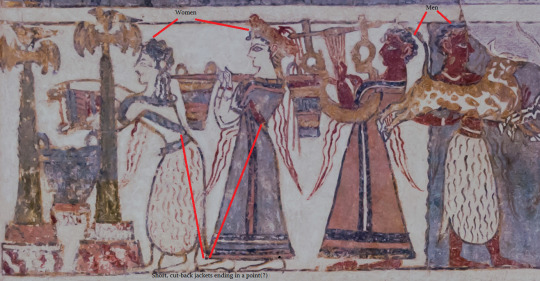
Here's one of the panels from the Hagia triada sarcophagus, from Crete during Mycenaean control/hegemony of the island. The women are painted white, the men dark; artistic aesthetic you see in other cultures for their visual arts of the time, like Ancient Egypt.
I think the fur(?) skirts might be religious wear, but aside from that, you have one woman and one man (specifically, the lyre player, which is probably indicative of some cultural attitudes; the lyre player in the fresco from Pylos is definitely wearing a fringed skirt of some sort, similar to what women wear) wearing a long robe/tunic, and the women are wearing some short jackets on top of that.
The jackets might be Cretan or merely "early" style, because here's a fresco fragment from the Greek mainland where the woman appears to wear something similar:
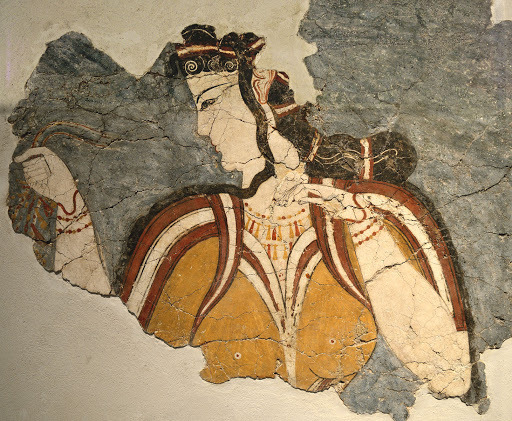
It's probable (but basically impossible to know) that the thing underneath is a long robe/tunic like the women above are wearing, short or sleeve-less.
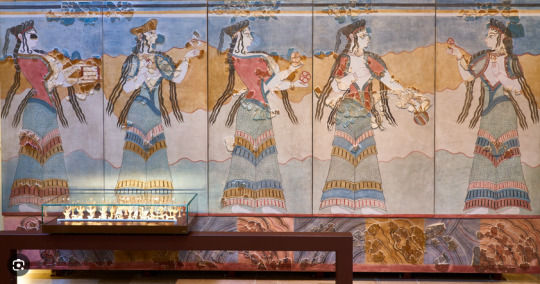
Another Mycenaean/mainland Greek fresco. In this one you'd have to decide if the top halves of the women's dress is a short (but not cut-away) jacket, plus wrap-around, tiered/fringed skirt, or a long robe/tunic with really deep neckline and, again, a wrap-around tiered/fringed skirt.
Now, you don't need to make things harder for yourself than you have to! Women can wear a simpler style of dress (like what the man in the first fresco panel is wearing), basically the same as the men's, probably just longer:
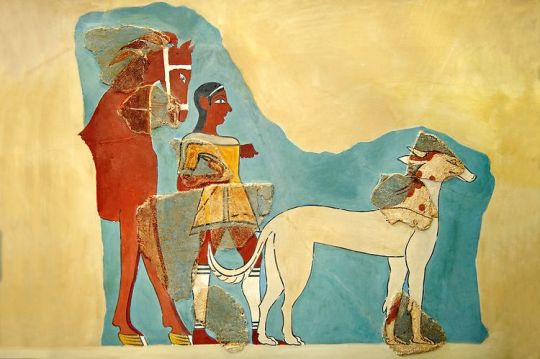
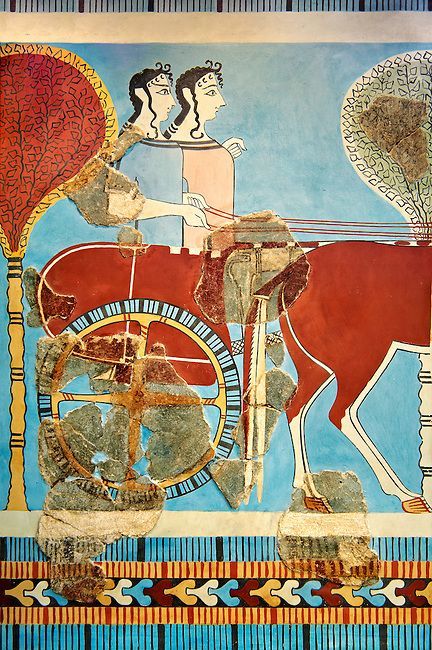
It's possible these two women are wearing wrap around skirts below the edge of the chariot, but I doubt it. As you can see, their style of dress is the same as the man's above, with a plain, straight collar.
The various lines you see plunging down the sides of both the longer robes/tunics and the shorter ones are down the sides (under the arms and down) and might also/either be down the front, at least on the long dresses with elaborate bottom rim; the woman in saffron above clearly has a decorated line going down her front.
I'll put the rest of this under the cut!

Some nice art with Mycenaean-era dress and armour for some of our Trojan war characters. (Aeneas and Hektor notably wearing Mycenaean wear even if they probably wouldn't be.)
I like this site http://www.salimbeti.com/micenei/index.htm for both art and a lot of pictures of artifacts when it comes to armour and weapons from the Mycenaean era.
The men don't just wear those tunics, though; you can get some (short) kilts or skirts;
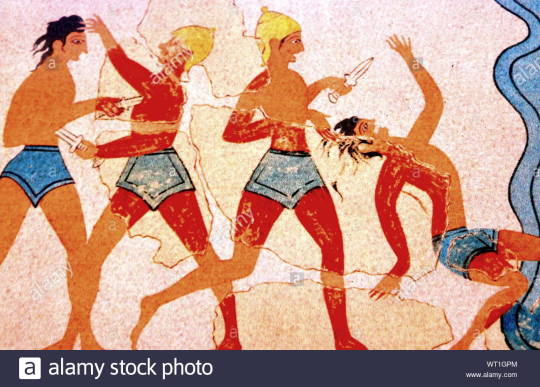
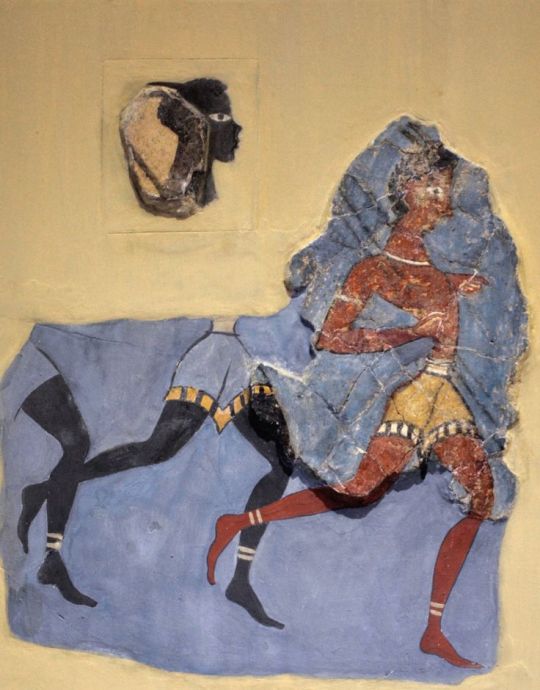
(In my opinion, I'd say it's basically a given the one/two dudes painted in basically black are meant to be from further south compared to the Greek dude here. Probably not sub-Saharan Africa, however. North Africa/Egyptian might be more reasonable, despite the impossibly dark skin.)
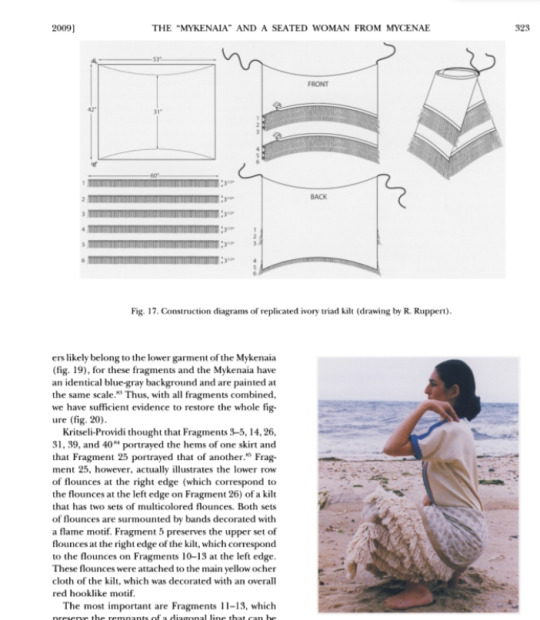

Some examples of the clothes recreated!
This article https://www.jstor.org/stable/20627591 talks about a fresco and its possible reconstructions, and, more importantly, includes photos of some women's clothes, especially the fringed/tiered wrap-around skirts recreated, and some drawing diagrams of said skirts that might be helpful!
Hair-wise, the majority of the men have hair anywhere from around the ears down to the shoulders in mainland Greece. (The exception being, again, the Pylian lyre player.)
Minoans, even mycenaean-era Minoans, might have longer hair; one of the panels on the Hagia triada fresco has a flute-player with hair down to his waist in braids (or something like that), for example.
All the women, no matter Cretan/Minoan or Mycenaean/Greek have very long hair, gathered in variously more or less elaborate hairstyles; make your best guess from looking at the frescos is my suggestion!
#greek mythology#trojan war#I might add a reblog for jewellery?#but trust me you can find lots of nice pictures of#mycenaean jewellery if you search exactly for that
377 notes
·
View notes
Note
Don't you threaten me with a forcestrange good time and then not follow through. I need you to absolutely abstract my ass. Dump some conceptual inversion up in me. Make my thoughts sound and my sounds taste and the taste of me sunlight and bitter ice and regret. Make me inhale cities and exhale apotheosis. Crush the idea of me under your big powerful boot and let the id of the collective unconscious reshape me into a place where every point on my vast and heaving form is the same place through a different lens. Touch me and feel the ancient pages of a genealogy of the Minoan kings crumble to dust under your fingers. Taste that dust; it is the last contented sigh of a person who died without regret, a person who never was and never will be. Fold me into a shape that is warm across your shoulders and sharp agony in the deep of your heart, and when you dance with me, I will be the flare of your dress as you spin, and the floor beneath your feet, and all the notes the music doesn't play, the space left behind when a shape was carved out of silence, echoing with every broken bowstring and broken promise. Really just fuck me right up.
wow, that’s quite an intriguing offer, and i’m not even a dom. new copypasta just dropped.
79 notes
·
View notes
Text

They look a bit wonky, but oh well. Minoan "let it all hang out" dresses.
150 notes
·
View notes
Text
Long Minoan Overskirt "Helen"

You're tired of colorless ancient worlds with the ever-the-same five garments you put onto your sims? Pep it up a little with this overskirt Minoan style!
- BGC
- for women, teen-elder
- disallowed for random
- 28 swatches, plain and patterned
- the texture covers the hat uv space, so it isn't compatible with hats or any cc that covers the same space
- tights category
- will fit over most EA and cc skirts, dresses and trousers. Will clip though, because skirts and their movement with the sim are different
This is my first very own from scratch mesh with many hours of work. Be fair, do not claim as yours.
Download under the cut
—
TOU: Keep it free. Be fair.
you may:
- use, spread, recolor and change the mesh as long as its use stays free from any kind of advertisement and financial gain on your side
- of course you don’t have to tag, but be assured that I’d be overjoyed to see you use my work 😁
you may not:
- link to the download using advertisement links such as ad*ly
- hand out the work in exchange for financial means or support, which includes paysites and simsdom
- claim as your own work
—
Download (always safe and free, direct link without ads)
All CC
#ts4 cc#ts4 historical cc#sims 4 historical cc#sims 4 cc#download#s4 historical cc#s4 cc#ts4 ancient civ cc#sims 4 ancient civ cc#s4 ancient civ cc#ts4 minoan cc#s4 minoan cc#sims 4 minoan cc
52 notes
·
View notes